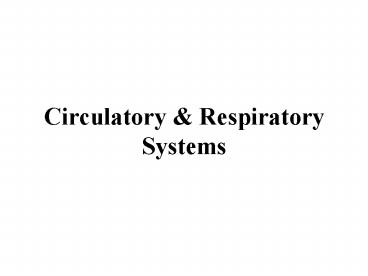Circulatory PowerPoint PPT Presentation
1 / 12
Title: Circulatory
1
Circulatory RespiratorySystems
2
Circulatory System
- The circulatory system provides the means,
through plasma and cellular components of the
blood, by which carbon dioxide and nitrogenous
wastes are transported to their respective exits
from the body.
3
Circulatory Components
- Heart - the circulatory system pump
- Arteries - carry blood away from the heart either
to the body (systemic, oxygenated) or to the
lungs (pulmonary, deoxygenated) - Veins - carry blood to the heart either from the
body (deoxygenated) or from the lungs
(oxygenated) - Lymphatic system - lymph vessels collect tissue
fluid produced by diffusion and filtration of
blood plasma at the capillary ends of the
arteries and return it to the venous system
cranial to the heart
4
Venous System
- Collects blood from the various parts of the body
and returns it to the right atrium of the heart
through the superior and inferior vena cava - Blood is deoxygenated
- Exception the pulmonary veins transport freshly
oxygenated blood from the lungs to the left
atrium of the heart
5
Arterial System
- Blood is pumped from the left ventricle of the
heart to the various parts of the body - Blood is oxygenated
- Exception the pulmonary arteries transport
deoxygenated blood from the right ventricle to
the lungs
6
CIRCULATION THROUGH THE HEART THE HEART AS A PUMP
RIGHT SIDE Blood enters the heart through two
large veins, the inferior and superior vena cava,
emptying oxygen-poor blood from the body into the
right atrium.
LEFT SIDE The pulmonary vein empties oxygen-rich
blood, from the lungs into the left atrium.
7
CIRCULATION THROUGH THE HEART THE HEART AS A PUMP
RIGHT SIDE Atrial contraction blood flows from
your right atrium into your right ventricle
through the open right atrioventricular
(tricuspid) valve. When the ventricles are full,
the right AV (tricuspid) valve shuts. This
prevents blood from flowing backward into the
atria while the ventricles contract
LEFT SIDE Atrial contraction blood flows from
your left atrium into your left ventricle through
the open left atrioventricular (bicuspid or
mitral) valve. When the ventricles are full, the
left AV (bicuspid) valve shuts. This prevents
blood from flowing backward into the atria while
the ventricles contract
8
CIRCULATION THROUGH THE HEART THE HEART AS A PUMP
RIGHT SIDE Ventricular contraction blood leaves
the heart through the pulmonary semilunar valve,
into the pulmonary artery and to the lungs.
LEFT SIDE Ventricular contraction blood leaves
the heart through the aortic semilunar valve,
into the aorta and to the body.
9
Circulatory Dissection
- Identify external and internal circulatory system
anatomy (including heart and lungs) - Identify the major arteries and veins
- Answer the question Are there valves located in
arteries and/or veins? - Look at arteries and veins in the forelimbs,
hindlimbs, heart, neck, and body cavity - Cut longitudinally
- Examine both cats and fetal pigs
10
Respiratory System
See Figure 11.10 on page 247 of you lab manual
for a more precise diagram
11
Oxygen CO2 Exchange
- Once blood travels through the pulmonary
semilunar valve, it enters the lungs via the
pulmonary arteries. This is called the pulmonary
circulation. Blood then enters the capillary
vessels in the lungs. Here, oxygen travels from
the tiny air sacs (alveoli) in the lungs, through
the walls of the capillaries, into the blood. At
the same time, carbon dioxide, a waste product of
metabolism, passes from the blood into the
alveoli. Carbon dioxide leaves the body upon
exhaling. Once the blood is purified and
oxygenated, it travels back to the left atrium
through the pulmonary veins.
12
Lab Notebook Assignment
- Diagram of heart (use Figure 10.2)
- Please note the left AV valve and aortic
semilunar valves are switched - Label and show blood flow through the heart
indicate where the blood is oxygenated and where
it is deoxygenated - Write this information out as well
- Answer the question about the presence of valves
in arteries and veins - Diagram of lungs (use figure 11.10)
- Write out the pathway of air from the outside of
the body to the alveoli

